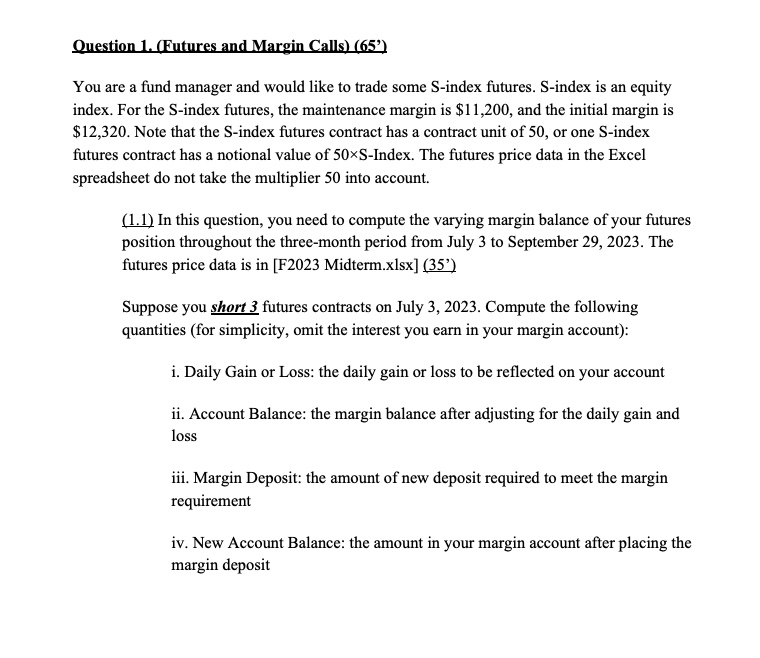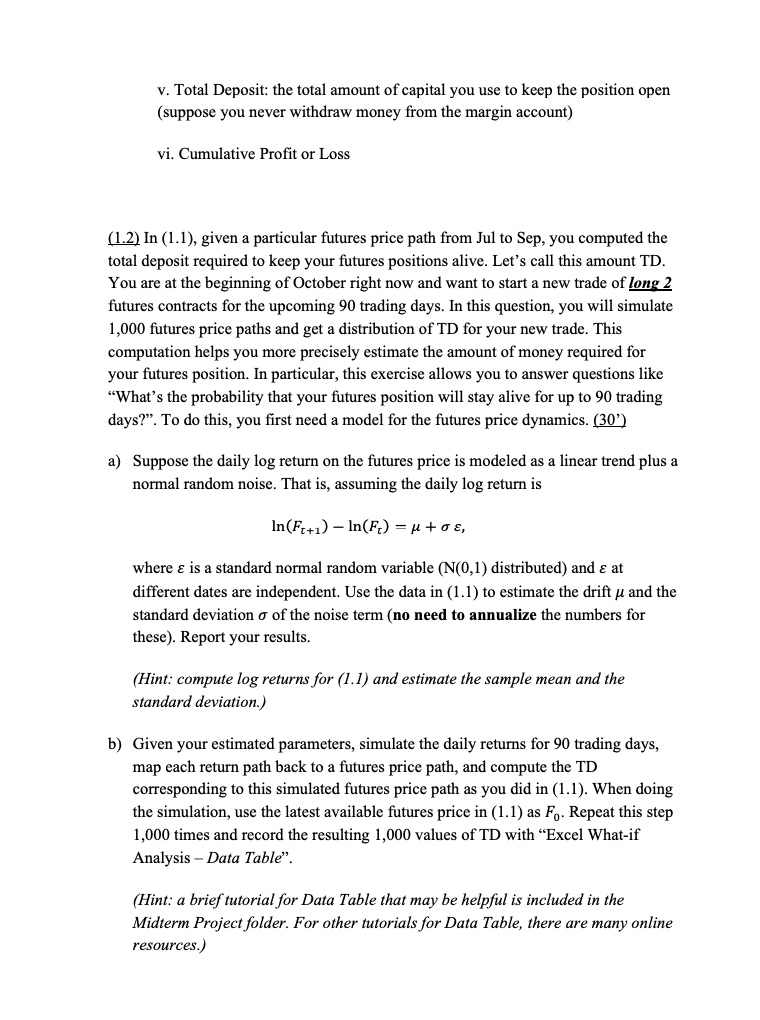Answered step by step
Verified Expert Solution
Question
1 Approved Answer
c) Now you have a distribution of the TD. You may compute a VaR type of measure of TD, i.e., what is the minimum amount


 c) Now you have a distribution of the TD. You may compute a VaR type of measure of TD, i.e., what is the minimum amount of money you need to keep your futures position (long 2 contracts) alive for 90 trading days with a 95% chance? v. Total Deposit: the total amount of capital you use to keep the position open (suppose you never withdraw money from the margin account) vi. Cumulative Profit or Loss (1.2) In (1.1), given a particular futures price path from Jul to Sep, you computed the total deposit required to keep your futures positions alive. Let's call this amount TD. You are at the beginning of October right now and want to start a new trade of long 2 futures contracts for the upcoming 90 trading days. In this question, you will simulate 1,000 futures price paths and get a distribution of TD for your new trade. This computation helps you more precisely estimate the amount of money required for your futures position. In particular, this exercise allows you to answer questions like "What's the probability that your futures position will stay alive for up to 90 trading days?". To do this, you first need a model for the futures price dynamics. (30') a) Suppose the daily log return on the futures price is modeled as a linear trend plus a normal random noise. That is, assuming the daily log return is ln(F+1)ln(F)=+ where is a standard normal random variable (N(0,1) distributed) and at different dates are independent. Use the data in (1.1) to estimate the drift and the standard deviation of the noise term (no need to annualize the numbers for these). Report your results. (Hint: compute log returns for (1.1) and estimate the sample mean and the standard deviation.) b) Given your estimated parameters, simulate the daily returns for 90 trading days, map each return path back to a futures price path, and compute the TD corresponding to this simulated futures price path as you did in (1.1). When doing the simulation, use the latest available futures price in (1.1) as F0. Repeat this step 1,000 times and record the resulting 1,000 values of TD with "Excel What-if Analysis - Data Table". 1 are a fund manager and would like to trade some S-index futures. S-index is an equity ex. For the S-index futures, the maintenance margin is $11,200, and the initial margin is 320. Note that the S-index futures contract has a contract unit of 50 , or one S-index Ires contract has a notional value of 50S-Index. The futures price data in the Excel adsheet do not take the multiplier 50 into account. (1.1) In this question, you need to compute the varying margin balance of your futures position throughout the three-month period from July 3 to September 29, 2023. The futures price data is in [F2023 Midterm.xlsx] (35') Suppose you short 3 futures contracts on July 3, 2023. Compute the following quantities (for simplicity, omit the interest you earn in your margin account): i. Daily Gain or Loss: the daily gain or loss to be reflected on your account ii. Account Balance: the margin balance after adjusting for the daily gain and loss iii. Margin Deposit: the amount of new deposit required to meet the margin requirement iv. New Account Balance: the amount in your margin account after placing the margin deposit
c) Now you have a distribution of the TD. You may compute a VaR type of measure of TD, i.e., what is the minimum amount of money you need to keep your futures position (long 2 contracts) alive for 90 trading days with a 95% chance? v. Total Deposit: the total amount of capital you use to keep the position open (suppose you never withdraw money from the margin account) vi. Cumulative Profit or Loss (1.2) In (1.1), given a particular futures price path from Jul to Sep, you computed the total deposit required to keep your futures positions alive. Let's call this amount TD. You are at the beginning of October right now and want to start a new trade of long 2 futures contracts for the upcoming 90 trading days. In this question, you will simulate 1,000 futures price paths and get a distribution of TD for your new trade. This computation helps you more precisely estimate the amount of money required for your futures position. In particular, this exercise allows you to answer questions like "What's the probability that your futures position will stay alive for up to 90 trading days?". To do this, you first need a model for the futures price dynamics. (30') a) Suppose the daily log return on the futures price is modeled as a linear trend plus a normal random noise. That is, assuming the daily log return is ln(F+1)ln(F)=+ where is a standard normal random variable (N(0,1) distributed) and at different dates are independent. Use the data in (1.1) to estimate the drift and the standard deviation of the noise term (no need to annualize the numbers for these). Report your results. (Hint: compute log returns for (1.1) and estimate the sample mean and the standard deviation.) b) Given your estimated parameters, simulate the daily returns for 90 trading days, map each return path back to a futures price path, and compute the TD corresponding to this simulated futures price path as you did in (1.1). When doing the simulation, use the latest available futures price in (1.1) as F0. Repeat this step 1,000 times and record the resulting 1,000 values of TD with "Excel What-if Analysis - Data Table". 1 are a fund manager and would like to trade some S-index futures. S-index is an equity ex. For the S-index futures, the maintenance margin is $11,200, and the initial margin is 320. Note that the S-index futures contract has a contract unit of 50 , or one S-index Ires contract has a notional value of 50S-Index. The futures price data in the Excel adsheet do not take the multiplier 50 into account. (1.1) In this question, you need to compute the varying margin balance of your futures position throughout the three-month period from July 3 to September 29, 2023. The futures price data is in [F2023 Midterm.xlsx] (35') Suppose you short 3 futures contracts on July 3, 2023. Compute the following quantities (for simplicity, omit the interest you earn in your margin account): i. Daily Gain or Loss: the daily gain or loss to be reflected on your account ii. Account Balance: the margin balance after adjusting for the daily gain and loss iii. Margin Deposit: the amount of new deposit required to meet the margin requirement iv. New Account Balance: the amount in your margin account after placing the margin deposit
Step by Step Solution
There are 3 Steps involved in it
Step: 1

Get Instant Access to Expert-Tailored Solutions
See step-by-step solutions with expert insights and AI powered tools for academic success
Step: 2

Step: 3

Ace Your Homework with AI
Get the answers you need in no time with our AI-driven, step-by-step assistance
Get Started


